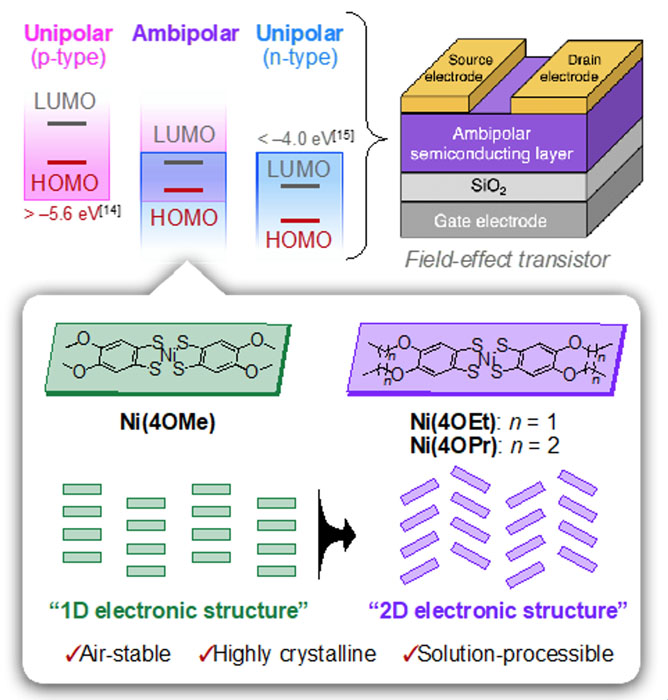Ambipolar Nickel Dithiolene Complex Semiconductors: from One to Two-Dimensional Electronic Structures Based upon Alkoxy Chain Lengths
Mori and Ozaki Groups
Molecular semiconductors, which are mainly based on π-conjugated organic molecules are crucial materials in fundamental research and electronics because they are flexible, light-weight, and can be solution-processed in a cost-effective, energy-saving manner. Among them, materials that can transport both holes and electrons are required for next-generation devices, such as organic light-emitting transistors and organic solar cells. Hence, materials that physically combine hole- and electron-transporting semiconductors in mixed or bi-layered forms have been used as dual transporters. However, poor interfacial contact between the two materials, where charge recombination or separation occurs, often leads to poor quantum efficiencies and reproducibilities. Instead, single-component ambipolar semiconductors that can transport both holes and electrons are promising materials capable of overcoming these obstacles. Polymer-based materials, such as donor–acceptor copolymers, exhibited ambipolar semiconducting characteristics. However, the structural inhomogeneity based on the inevitable wide-ranged molecular weight distribution severely hampered access to the structural insights and the conduction mechanism, hampering the establishment of the materials designing guidelines. Therefore, we focused on the single-molecular-weight ambipolar organic semiconductors that offer excellent tunability of electronic structures and crystallinity to access the structural insights and conduction mechanism.
Our groups have designed and synthesized d/π-conjugated molecules, Ni(4OR) [R = Me, Et, Pr] (Fig. 1) [1,3], in which the nickel element with d electrons plays a central role. These molecules are highly stable and do not react easily with water or oxygen, and are also attractive because they can be easily synthesized using nickel, which is a relatively inexpensive metallic material. In addition to the electronic structure and properties, molecular semiconductors with excellent carrier transport properties requires seemingly contradictory properties: high crystallinity to enable highly ordered and highly dimensional stacking states, and high solubility to realize excellent thin-film processability. The research group searched for new materials that fulfil these conditions among combinations of d/π-conjugated backbone and side chains, and found a group of d/π-conjugated molecules that achieve both.
Unexpectedly, it was found that slight differences in the number of carbons on the side chains dramatically changed the stacking structure in single crystals. Those with one carbon substituent exhibited a one-dimensional stacking pattern, while those with two or three carbons exhibited a herringbone-type stacking pattern with a two-dimensional electronic structure, which is advantageous for stable device operation (Fig. 1). The latter stacking pattern was reproduced in thin films with a thickness of several tens of nanometres, which were constructed by solution coating, and highly ordered crystalline thin films were successfully realized. Field-effect transistor devices in which the resulting thin films were inserted as semiconductor layers exhibited ambipolar charge transport properties and showed high levels of both carrier mobility (up to 10−2 cm2V−1s−1) and on-off ratio (105). These performances were demonstrated in an open environment without the strict exclusion of water and oxygen, enabling the realization of a new ambipolar semiconductors with high stability, solution-dispensable and high mobility.

Fig. 1. (Top) Electronic structure requirements for ambipolar semiconductors used in field-effect transistors (FET), where the electronic structure requirements imposed on p-type/n-type semiconductors must be compatible with each other. (Bottom) Schematic diagram of the structural formula of the novel complex developed in this study and its molecular stacking pattern. Single crystal X-ray structure analysis revealed a dramatic modulation of the molecular stacking pattern associated with a slight extension of the side chains, and theoretical calculations confirmed the acquisition of dimensionality (D) from 1D to 2D.
In summary, novel molecular ambipolar semiconductors, Ni(4OR) [R = Me, Et, Pr], which are inexpensive and easy to synthesize, resistant to reaction with water and oxygen, and possible to solution process, have been developed and exhibited excellent carrier mobility and on-off ratio. The availability of structural information at the atomic level has enabled detailed electronic structure and conduction mechanism analysis, and has revealed molecular design guidelines for superior semiconductors, which have not been established for polymer materials. In the future, it is expected that d/π-conjugated molecules will be developed by utilizing the high degree of structural freedom based on the combination of the central metal and ligand towards high transport properties through a higher-dimensional electronic structure based on changes in stacking pattern according to the number of carbons on the side chains. Such a detailed material design strategy using molecular materials can be extended not only to electrically conductive materials but also to various applications such as magnetic materials and photo-functional materials and is expected to make a significant contribution to the development of next-generation organic electronic devices.
References
- [1] M. Ito, T. Fujino, L. Zhang, S. Yokomori, T. Higashino, R. Makiura, K. J. Takeno, T. Ozaki, and H. Mori, J. Am. Chem. Soc. 145, 2127 (2023).
- [2] D. Zhang, S. Yokomori, R. Kameyama, C. Zhao, A. Ueda, L. Zhang, R. Kumai, Y. Murakami, H. Meng, and H. Mori, ACS Appl. Mater. Interfaces 13, 989 (2021).
- [3] S. Yokomori, S. Dekura, A. Ueda, R. Kumai, Y. Murakami, and H. Mori, J. Mater. Chem. 9, 10718 (2019).
